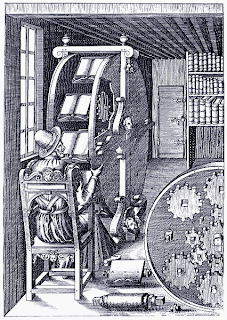 |
| "So if I push this here..." |
The Bag applies some of the ideas from interactive fiction, or "text adventure" games, to go beyond just laying out what a thing does and what it is. Just as important is how you interact with it. In classic interactive games like Adventure or Zork, it's important to get the right verb. "ROTATE HANDLE" won't work, where "TURN HANDLE" will. "BREAK HANDLE" might not work, but if it's a carefully coded game, you might get some message for that, even if only to tell you it's impossible.
This action layer - Table D in my system - allows for some of the most plausible actions on a special object to have meaningful consequences.
Cut the curtain, and a ghost might be released. Throw water on it, and a treasure map might appear. Text adventure veterans know to throw every verb in the book at a situation, but tabletop roleplayers don't have all the time in the world. So, it's important to put some clues in. A shifting face might be visible on close inspection in the curtain's patterns - clue to the ghost. A diary you found elsewhere might say that the map is found in the room where the curtain is, and the knowledge is open to minds that are "not too dry."
There's an art to making all the pieces of a trick come together in a satisfying whole, which for me anyway is a lot of fun. Here are the first three tricks I test-generated with the Endless Bag:
1. This stairway down is “guarded” by a pair of high leather boots standing on the top step, toes toward the stairs. If one or both of the boots are moved, a transparent skeletal figure will rise up out of them, gesturing wildly and pointing to its many broken bones, then vanish. If the boots are not put back to exactly where they were, anyone stepping on the stairs must save or fall down the staircase, receiving blows and kicks as they go, and taking 4d6 damage. If the boots are not disturbed, nothing happens.
2. This is an ancient and dilapidated pipe organ set in the wall. The keys and pedals don’t work. The seat opens up and 200 gp worth of old sheet music is found in there. One of the blocks next to the wall is loose; there is a small crowbar next to it with the tag “Don’t get this wrong!” “Getting it wrong” in this case means taking an unknown person’s advice in the dungeon … If the block is slid deeper inside the wall, a fragile, ornamented egg will fall gently to the ground inside the wall, worth 100 gp. If the block is pried out, a poison dart will shoot out from deep within the wall, smashing the egg, attacking anyone in front of it as a 5th level thief and doing 1d3 + 2d10 poison damage. Pushing the block in stops the dart, and the egg will fall without harm.
3. This is a cozy fireplace set in the wall, with no chimney, a smokeless fire blazing, an a bucket of water nearby. If the fire is extinguished, it will collapse into ash and a choking cloud of thick smoke 20 by 20 feet, and a sooty imp will jump out and attack. Anyone in the smoke except the imp is at -2 to hit. The fireplace will be found to be choked with thick ash, but if this is cleaned – obviously assuming the fire has been put out – a shining white brick among the blackened bricks of the fireplace will be found. Just touching the brick with bare fingers will give a vision of how to deal with the white brick wall in area X. Pushing the brick, however, will collapse the fireplace on the character, giving 4d6 damage with no save.
Hope you enjoy the Endless Bag of Tricks and can use it in your own game!







